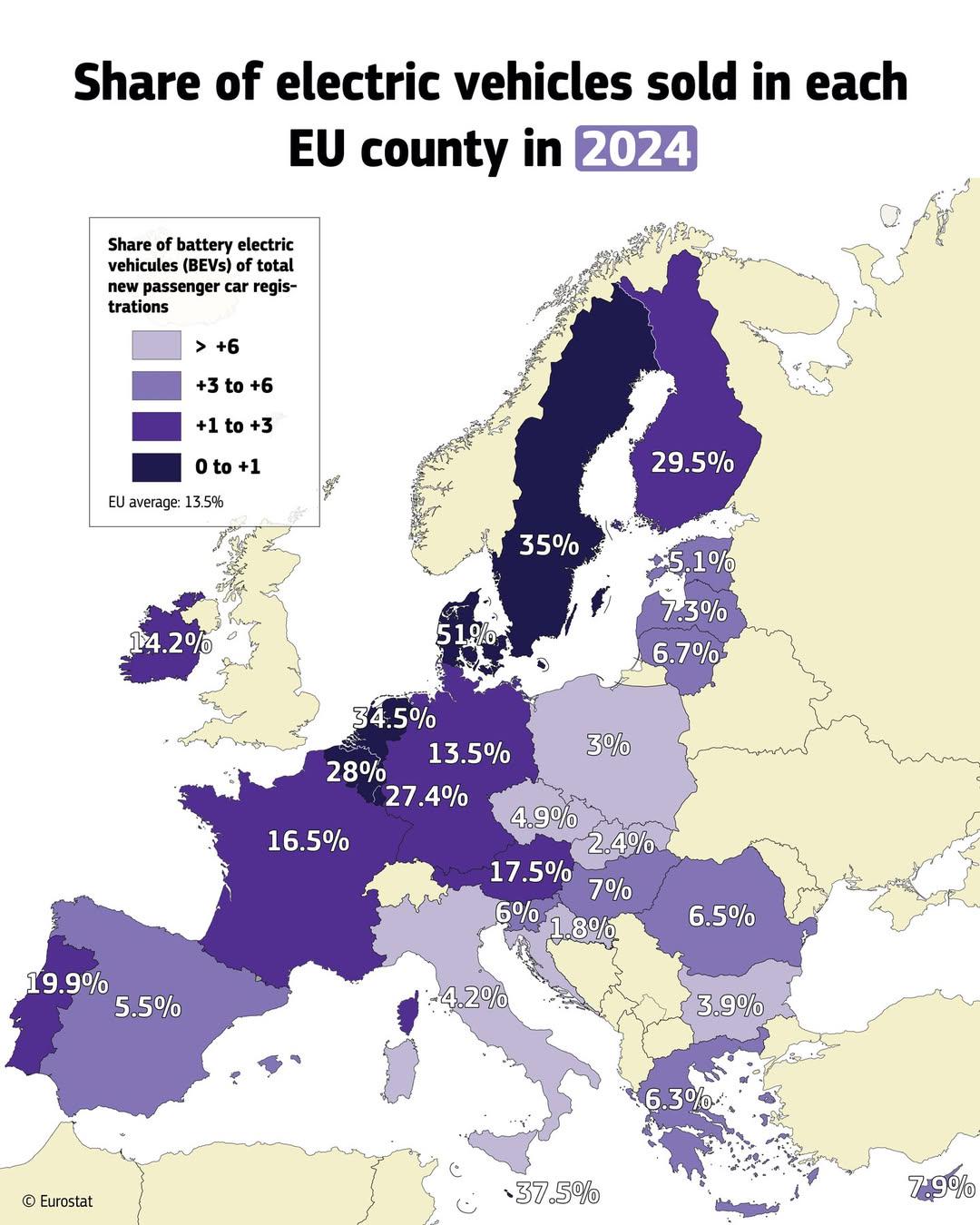Electric Vehicle Sales Share by EU Country Map


Alex Cartwright
Senior Cartographer & GIS Specialist
Alex Cartwright is a renowned cartographer and geographic information systems specialist with over 15 years of experience in spatial analysis and data...
Geographic Analysis
What This Map Shows
The "Share of Electric Vehicles Sold in Each EU Country (2024) Map" provides a clear visual representation of the market penetration of electric vehicles (EVs) across European Union nations. This map highlights the percentage of new car sales that are electric vehicles, giving us a snapshot of how different countries are embracing sustainable transportation. As global focus shifts towards reducing carbon emissions and promoting clean energy, understanding the dynamics of EV sales in the EU is crucial.
Deep Dive into Electric Vehicle Adoption in Europe
Electric vehicles are at the forefront of the automotive industry’s shift towards sustainability, with Europe leading the way in adoption rates. The European Union has set ambitious targets to combat climate change, aiming to have at least 30 million electric vehicles on the roads by 2030. One of the key factors driving this change is the EU's stringent regulations on carbon emissions for new cars, which incentivizes manufacturers to produce more electric models.
Interestingly, as of 2024, the overall share of electric vehicles sold in the EU has seen significant growth. Countries like Norway and Sweden are leading the charge, with electric vehicles accounting for more than 50% of total new car sales. Norway, for example, has become a model for EV adoption, largely due to its comprehensive incentives for electric vehicle buyers, including tax exemptions, toll-free travel, and access to bus lanes.
Conversely, countries like Bulgaria and Romania show much lower percentages of electric vehicle sales, hovering around 5% or less. Factors contributing to these disparities include economic constraints, limited charging infrastructure, and varying levels of government support for EV initiatives. In some nations, traditional combustion engines remain dominant due to lower upfront costs and the familiarity of consumers with conventional vehicles.
A critical element in understanding EV adoption is the availability of charging infrastructure. Countries with robust networks of charging stations tend to have higher rates of electric vehicle sales. For instance, the Netherlands boasts one of the highest densities of charging points per capita in Europe, facilitating easier access and comfort for potential EV buyers. In contrast, nations with inadequate charging facilities often see slower adoption rates.
Regional Analysis
When we analyze the map regionally, several trends emerge. Northern Europe, particularly the Scandinavian countries, leads in electric vehicle market share. Norway, as mentioned, stands out with its impressive figures, while Sweden and Finland follow closely behind, each benefiting from supportive government policies and public awareness campaigns promoting green transportation.
In Western Europe, countries such as Germany and France are making strides as well, with electric vehicle sales on the rise thanks to a combination of consumer incentives and a strong automotive manufacturing base. Germany, being home to major car manufacturers, has seen traditional brands pivot towards electric models, further boosting sales.
Southern Europe, including countries like Italy and Spain, shows a more mixed picture. While there is growing interest in electric vehicles, economic factors and cultural attitudes towards car ownership can slow down adoption rates. Moreover, the economic impact of the COVID-19 pandemic has led to many consumers prioritizing affordability over sustainability, affecting EV purchases.
Eastern Europe, on the other hand, tends to lag behind the rest of the EU in electric vehicle sales. Countries such as Poland and Hungary are still heavily reliant on coal and fossil fuels, and the transition to electric vehicles is hampered by both infrastructure and economic challenges. However, there's a noticeable increase in awareness and government initiatives aimed at boosting electric vehicle adoption in these regions, signaling a potential shift in the coming years.
Significance and Impact
The importance of tracking electric vehicle sales shares cannot be overstated. As Europe strives to meet its climate goals and reduce greenhouse gas emissions, understanding where electric vehicles are succeeding and where they are struggling offers insights into the effectiveness of policy measures and consumer behavior. The push towards electric vehicles is not merely a trend; it represents a fundamental shift in the transportation paradigm.
Moreover, the implications extend beyond environmental concerns. The transition to electric vehicles can have significant economic impacts, driving innovation in technology, creating new jobs in the green economy, and reducing reliance on fossil fuels. Furthermore, as more countries commit to phasing out internal combustion engines, the automotive industry is undergoing a transformative shift that will shape the future of mobility.
As we move forward, keeping an eye on these trends will be essential for policymakers, businesses, and consumers alike. Understanding the dynamics of electric vehicle adoption in the EU can help shape strategies to enhance infrastructure, improve incentives, and ultimately, drive a more sustainable future for transportation. What’s fascinating is that as we witness this transformation, we are also part of a larger narrative on climate action and sustainability in our everyday lives.
Visualization Details
- Published
- September 18, 2025
- Views
- 60
Comments
Loading comments...